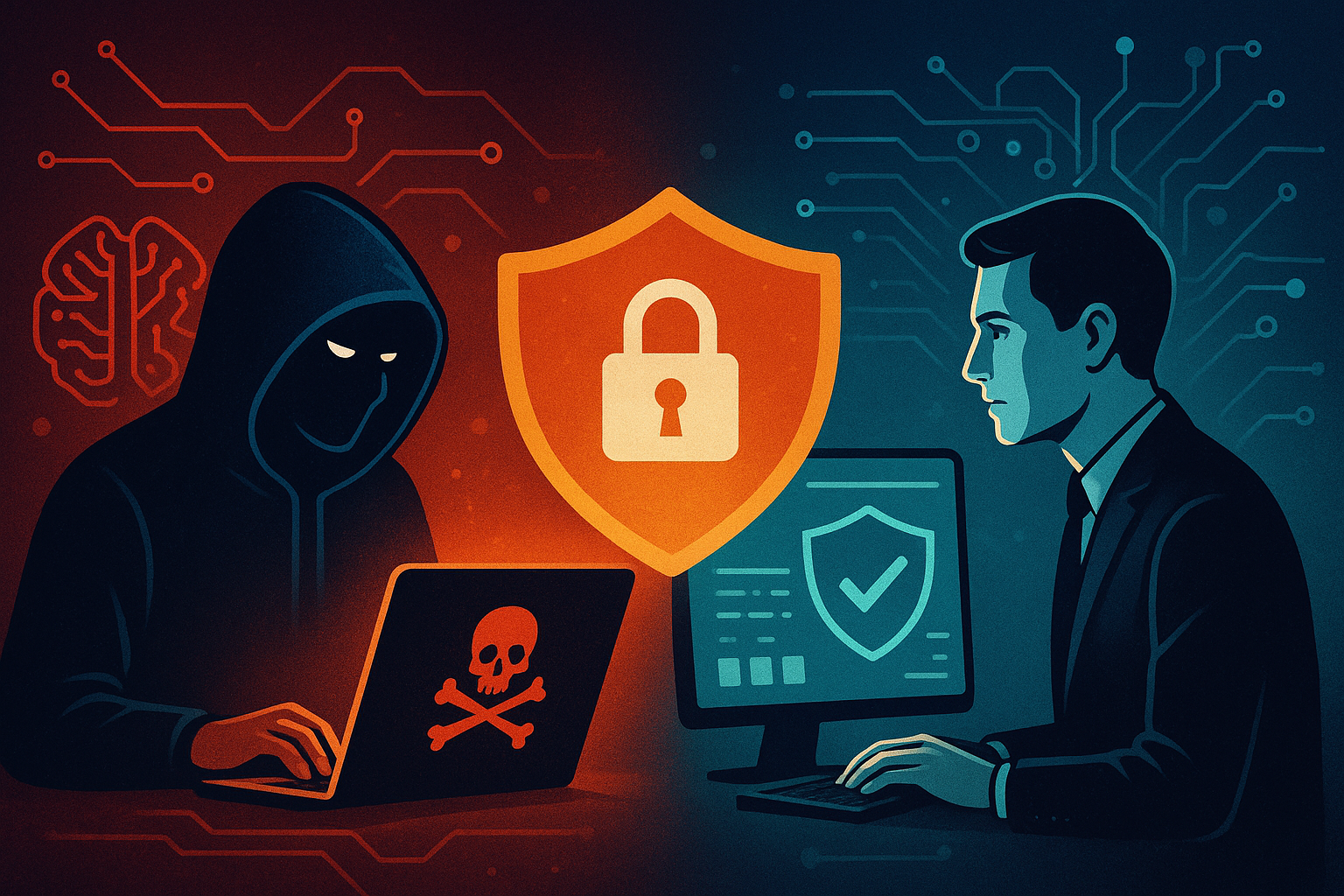Artificial intelligence (AI) has rapidly become one of the most transformative technologies of the 21st century. From business operations to national defense, AI systems are reshaping how societies function and how threats are countered. But with progress comes peril: the same algorithms that can safeguard a network or predict cyberattacks can also be weaponized to orchestrate large-scale, automated assaults. In this dual‐use landscape, the debate intensifies. When AI is both attacker and defender, what role is left for the human factor?
This article examines AI’s offensive and defensive capacities, the risks of autonomous digital conflict, and whether humans still matter in a battlefield increasingly dominated by algorithms.
AI as an Attacker
1. Automation of Cyber Offense
Traditional cyberattacks have always required human expertise. Hackers needed to craft malware, exploit vulnerabilities, and coordinate attacks manually. With AI, however, many of these tasks can now be automated. Machine learning algorithms can:
- Scan for vulnerabilities at speeds far surpassing human hackers.
- Generate polymorphic malware that constantly mutates to evade detection.
- Use reinforcement learning to test attack strategies and optimize them in real time.
This automation lowers the barrier to entry, enabling even less-skilled actors to conduct sophisticated attacks once reserved for elite cybercriminal groups. A recent report by the Center for Security and Emerging Technology (“Anticipating AI’s Impact on the Cyber Offense-Defense Balance”) explores how AI tools change the dynamics of offense and defense in cybersecurity. (CSET)
2. Social Engineering Powered by AI
Perhaps the most insidious use of AI in offense is its role in social engineering. AI-driven natural language models can create spear-phishing emails indistinguishable from genuine communications. Deepfake technologies add another dimension, allowing attackers to generate convincing fake videos or voices of trusted individuals. The risks are underscored in recent commentary on how attackers exploit people, not just systems. For example, Forbes has an article on “The Human Factor: Redefining Cybersecurity In The Age of AI” that emphasizes how human error is one of the biggest vulnerabilities. (Forbes)
3. AI in Military and Physical Security
Beyond cyberspace, AI has offensive applications in kinetic warfare. Autonomous drones capable of selecting and engaging targets raise profound ethical and security concerns. Swarm attacks, where hundreds of inexpensive drones coordinate using AI, could overwhelm traditional defenses.
One real‐world example: the Project Maven initiative (US) uses machine learning and data fusion to process imagery and target recommendations, while humans remain in the loop for final decisions. (Wikipedia)
4. Adaptive Attacks
Unlike static malware, AI-driven attacks can adapt on the fly. For example, if an intrusion detection system blocks one pathway, the AI may immediately shift tactics, probing for another vulnerability. This adaptability mirrors the way AI in other domains (e.g., games) learns from feedback and adjusts. Papers on adversarial machine learning and attack modeling explore such adaptive threats. (arXiv)
AI as a Defender
1. Speed and Scale of Detection
Defending against modern cyber threats requires analysing enormous volumes of data—network traffic, system logs, user behaviour, that humans simply cannot process in real time. AI excels at pattern recognition, anomaly detection, and predictive modelling. By leveraging these capabilities, organisations can:
- Spot zero‐day exploits before they spread widely.
- Detect insider threats by identifying deviations from typical employee behavior.
- Automate incident response, reducing the time between detection and containment.
The report The Most Useful Military Applications of AI in 2024 and Beyond lists several defense sector use-cases of AI including threat monitoring, border surveillance, and cybersecurity. (Sentient Digital, Inc.)
2. Proactive Defense Through Prediction
AI doesn’t just react it can anticipate. By analysing threat intelligence feeds, dark web chatter, and global attack patterns, AI systems can predict potential attack vectors before they materialise. This shifts cybersecurity from a reactive model to a predictive and preventive one. The Frontier AI’s Impact on the Cybersecurity Landscape article from Berkeley’s RDI explores how AI lowers barriers for attackers but also how defenders can anticipate and harden systems. (Berkeley RDI)
3. Defending Against Social Engineering
Ironically, the same AI that enables convincing phishing can also help defend against it. Machine learning can analyze email and messaging metadata to detect subtle markers of fraudulent communications. Likewise, deepfake detection algorithms are improving, able to spot inconsistencies in generated audio or video that humans would miss.
4. Resilience in Kinetic Domains
In physical security and defense, AI enhances surveillance, anomaly detection, and counter‐drone measures. For example, the Indrajaal Autonomous Drone Defence Dome in India uses AI to monitor large airspaces and neutralize threats from drone swarms. (Wikipedia) Also, the Akashteer system is another Indian example: an automated air defence control and reporting system using AI, integrating sensor data from multiple sources. (Wikipedia)
The Human Factor: Still Relevant?
As AI grows more capable, some argue that human oversight may become redundant. After all, if AI can out think attackers and instantly neutralise threats, why not let it run autonomously? Yet the human factor continues to matter, for reasons both technical and ethical.
1. The Problem of Explainability
AI systems often operate as “black boxes,” making decisions in ways even their designers cannot fully explain. In critical contexts such as defense or financial security, humans need to understand why a system flagged a threat, denied access, or launched a countermeasure. Without explainability, trust erodes, and the potential for catastrophic mistakes grows.
2. Ethical and Legal Accountability
AI cannot be held legally responsible for its actions, humans can. If an autonomous defensive system mistakenly takes down critical infrastructure, who is accountable? Governments, corporations, and military organisations cannot abdicate human responsibility for life-and-death decisions. Ethical frameworks demand human oversight, particularly in scenarios involving lethal force. The Military AI as Sociotechnical Systems article notes that many countries currently use AI as decision support, not full delegation, precisely to retain human control. (Lieber Institute West Point)
3. Creativity and Intuition
While AI excels at recognising patterns, it lacks human intuition and creativity. Attackers often exploit unexpected vulnerabilities like the human tendency to reuse passwords or misconfigure security tools. Humans can anticipate these “irrational” behaviours in ways algorithms cannot. On the defence side, human analysts bring contextual judgement, integrating geopolitical, cultural, or organisational factors into threat assessments.
4. AI’s Vulnerability to Manipulation
AI systems themselves can be attacked. Adversarial machine learning , feeding AI with carefully crafted data to mislead it—remains a potent threat. For example, some technical work proposes defenses like the “Dynamic Neural Defense” architecture to guard AI from adversarial attacks. (arXiv) Similarly, works on stable diffusion based defenses address adversarial robustness. (arXiv)
5. Psychological and Social Dimensions
Security is not purely technical, it is also social. Employees need training, reassurance, and awareness of threats. No matter how advanced AI defenses become, humans will always be the ultimate targets of manipulation. Defense strategies must therefore combine technological safeguards with human education and resilience.
The Future: Symbiosis, Not Replacement
The relationship between AI attackers and defenders resembles an arms race. Offense leverages AI to launch more convincing, adaptive, and large-scale attacks. Defense responds with equally sophisticated detection, prediction, and response systems. Yet neither side can completely eliminate the human factor.
1. Human-AI Collaboration
The most effective defense strategies will be those that blend machine efficiency with human judgment. AI can filter massive data streams and highlight anomalies, while human analysts decide on the broader implications. This symbiosis not only strengthens defenses but also ensures accountability and trust. The article Keeping the Human Touch with Agentic AI addresses exactly this: many AI tools can automate repetitive tasks, but human validation is needed especially where stakes are high. (ISC2)
2. Policy and Governance
Humans are needed to shape the ethical and regulatory frameworks governing AI in security. International agreements on autonomous weapons, corporate policies on data usage, and government regulations on AI deployment all require human deliberation. AI may suggest optimal strategies, but only humans can weigh them against moral, social, and political considerations.
3. Continuous Learning
Both attackers and defenders are engaged in a continuous learning cycle. Humans are essential in feeding real-world context into AI systems, updating training data, and interpreting outputs. Without human input, AI risks becoming static and predictable , an exploitable weakness in a dynamic environment.
4. Psychological Assurance
Finally, there is the human need for reassurance. Even if AI were capable of perfectly defending a network, organizations would still require human oversight to instill confidence among stakeholders. Security is as much about perception and trust as it is about technical reality.
Conclusion
The rise of AI has transformed both sides of the security equation. As an attacker, AI enables automation, deception, and adaptability at unprecedented scales. As a defender, AI provides speed, foresight, and resilience beyond human capacity. Yet amid this escalating algorithmic arms race, the human factor remains indispensable.
Humans provide context, creativity, and ethical judgment that AI cannot replicate. They ensure accountability in decisions that affect lives and livelihoods. They also remain the primary targets of manipulation reminding us that technology alone cannot secure societies.
Ultimately, the future of security will not be AI replacing humans, but AI augmenting them. The strongest defenses will emerge not from machines alone, but from a partnership where humans and AI complement one another combining the precision of algorithms with the wisdom of human judgment. In this balance lies the only sustainable path forward in a world where attackers and defenders alike wield AI as their weapon of choice.
Additional Reading & References
- Anticipating AI’s Impact on the Cyber Offense-Defense Balance (CSET) – detailed report on how AI tools affect the attacker-defender dynamics. (CSET)
- The Human Factor: Redefining Cybersecurity in the Age of AI (Forbes) – explores how human vulnerabilities are often the weakest link. (Forbes)
- Defense AI Technology Worlds Apart From Commercial AI (Northrop Grumman) – how defense AI differs, especially with human decision-makers in the loop. (Northrop Grumman)
- The Role of Human Factors in Enhancing Cybersecurity (ScienceDirect) – recent work categorizing how human behavior matters in cybersecurity risk. (ScienceDirect)
- Military AI as Sociotechnical Systems (West Point / Lieber Institute) – discusses norms, governance, and the “human in the loop” in weapons policy. (Lieber Institute West Point)
If you like, I can insert hyperlinks in all sections (clickable) and format it like an online journal article. Do you want me to revise it that way?

